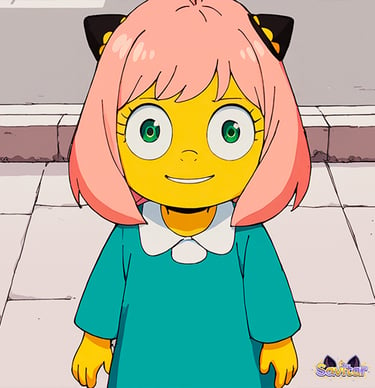🔥Access +100 Characters NSFW Hardcore for just $9.99 Monthly 😈
When Cartoons Become 'Real': The Simpsons Court Case
Explore the absurdity of the Simpsons court case where animated characters were treated as real people under the law. Discover how this ruling challenges the line between fiction and reality.
NEWS
Savitar
9/24/20243 min read


In December 2008, a man from Sydney was convicted for possessing certain images involving The Simpsons characters. But the most baffling part? The court ruled that these animated characters, despite being entirely fictional, could be considered “real people” under the law. Yes, you read that right—Bart, Lisa, and the rest of the Simpsons crew were treated as if they were actual humans.
Let’s take a second to wrap our heads around this. Bart Simpson, a cartoon character with bright yellow skin, who’s been the same age for over 30 years, is now legally considered a "real person." The idea that someone could face legal consequences for images of fictional, exaggerated cartoon characters is as bizarre as it gets. It’s hard to fathom how a group of adults sat in a courtroom and decided that these characters, with their oversized heads and timeless youth, somehow represent actual human beings.
And this opens a Pandora’s box. If The Simpsons are “real,” what’s next? Will people be fined for fan art of SpongeBob because he might, in some parallel universe, represent a deep-sea diver? Or maybe you should think twice before drawing Superman—after all, he does look kind of human.
But let’s not forget one of the most famous scenes in The Simpsons Movie. Remember when they showed Bart’s—you know what I’m talking about—his naked scene on a giant screen? Yeah, that’s right. Bart’s little "exposure" was shown in theaters worldwide. So, what now? Should everyone involved in the production be thrown in jail too? Oh, wait—never mind! It’s a multi-million-dollar studio, so of course, they get a pass. Silly me for thinking it’d be held to the same standards.
The absurdity here is not just in the conviction, but in the precedent it sets. Fictional characters have always existed in their own universe—detached from the real world, confined to the boundaries of imagination. The fact that a court could treat these characters as real beings raises questions about how we understand fiction and reality, and where we draw the line between the two.
A Dangerous Precedent
What makes this case even more surreal is how it stretches the legal definition of "person." Suddenly, cartoons that were never intended to be anything more than exaggerated, satirical figures become part of a legal debate. If Bart Simpson, who’s been causing trouble in Springfield for over three decades, is now considered a real person, where does this leave the rest of the animated world?
Can artists or fans now be held accountable for content involving entirely fictitious characters simply because a court deems them "real"? It’s not hard to see how this could spiral into a mess. Today it’s The Simpsons, but tomorrow it could be any number of beloved characters who are suddenly deemed "too close to reality."
Fiction vs. Reality
It’s important to remember that fiction exists in its own bubble. These characters—whether they’re from The Simpsons or any other animated series—are creations of imagination, meant to live in a world of their own. That’s the beauty of fiction: it’s not real, and it never pretends to be.
The notion that a cartoon could be treated as real in a court of law challenges the very foundation of artistic freedom. Artists, writers, and creators have long relied on the understanding that what happens in fiction stays in fiction. But rulings like this muddy the waters and could have far-reaching consequences for creators everywhere.
Conclusion: When Law Meets Absurdity
At the end of the day, this case highlights the absurdity of applying real-world laws to characters that have never, and will never, exist in the real world. Sure, The Simpsons might feel familiar because they’ve been part of our cultural landscape for so long, but let’s not lose sight of the fact that they are, and always will be, fictional characters.
If courts continue down this path, we’re left with a future where the line between fiction and reality becomes increasingly blurred—where the world of imagination is subject to the same rules and regulations as the physical world. And that’s a slippery slope we might not want to go down.
So next time you’re watching The Simpsons, just remember: they’re not real. But according to one court, they’re close enough.


